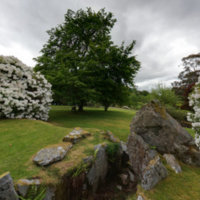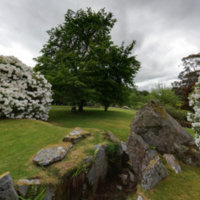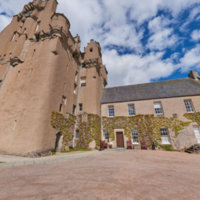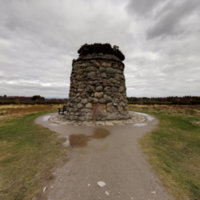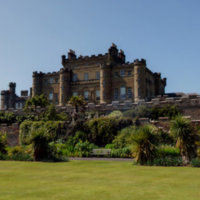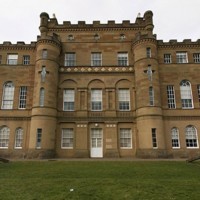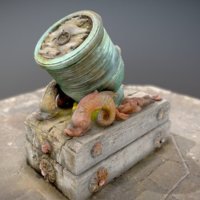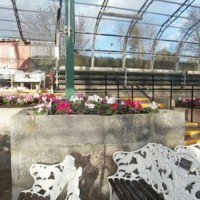Browse Items (4104 total)
Sort by:
Cramond Kirk
Cramond Kirk is a church situated in the area of Cramond in the north west of Edinburgh, Scotland. Built on the site of an old Roman fort, parts of the Cramond Kirk building date back to the fourteenth century and the church tower is considered to be…
Crarae Garden (National Trust for Scotland)
Crarae is one the finest examples of Himalayan-style woodland gardens in Britain. The 50 acre site is situated in an area of outstanding natural beauty on the banks of Loch Fyne in Argyll, Scotland. Crarae Garden was created in 1912 by Lady Grace…
Crathes Castle
This 16th century tower house was built by Alexander Burnett and is a maze of turrets and corridors featuring elaborately painted ceilings and wood panelled floors. It sits in a glorious set of gardens amongst the low hills of the area.
The inside…
The inside…
Crathie Kirk
Crathie Kirk was designed in a cruciform plan in the Scots Gothic style with a distinctive steeply pitched gabled nave and square, corbelled, parapetted crossing tower with splay footed spire. Crathie church is a well designed compact church which…
Crawfordjohn Heritage Venture
This Parish Church dates from 1817 and is situated on a raised circular mound, indicating that this was once a religious site dating back to the 12th century. The village of Crawfordjohn was established in the 12th century by John, stepson of…
Crawick Multiverse
?Crawick Multiverse is a world-class landscape designed by the renowned artist Charles Jencks. Formerly an open-cast coal mine, a 1 million restoration project saw the site transformed from a blot on the landscape to a stunning attraction that can be…
Creetown Heritage Museum
You’ll find Creetown Heritage Museum on the main street of Creetown, a village once known as ‘Ferrytown of Cree’ because ferries used to cross the River Cree here, right back to the days when pilgrims made their way to the shrine of St Ninian at…
Crocket's Land
Originally very much part of the Medieval street plan of the West Bow, the house burnt down in the early 18th century and was replaced with an interesting Dutch gabled building with its own internal timber stairs. The house retains its internal…
Croft-an-Righ House
17C corner-turreted L-plan house with an interesting decorated ceiling of probably 1640s. Until recently divided into 2 flats for Palace gardening staff, but now restored by Historic Scotland as their regional office.
Cromar Parish Church (St Moulag's)
Cromar Parish Church, also known as St Moulag?s, was built in the Gothic style and is very large and striking for a small village; the south principal elevation is particularly noteworthy. The south face was built with fine ashlar granite, while the…
Cromarty Courthouse Museum
This A Listed building was completed in 1773 by George Ross, owner of the Cromarty Estate, using Government funds from lands forfeited after the unsucessful 1745 Jacobite Rising. The old Mercat Cross was moved to the front of the building just after…
Cromarty East Church
More than 700 years ago, a parish church was built nestled next to a burn and close to the Royal Burgh of Cromarty. Now known as the East Church, the church has stood firm on the same foundations ever since, a witness to changing religious practice,…
Cromarty House
An imposing Georgian mansion, built for George Ross of Pitkerrie soon after he acquired the Cromarty Estate in 1722 and restored by the Nightingale family since the 1960's. The architect is unknown although Ross had close links with the Adam Brothers…
Cromarty House - The Stables
Lying to the south east of Cromarty House are the Cromarty House Stables of 1772. After lying derelict for many years, they were restored and are now used as an arts centre and artist studios. The magnificent plaster vaulted ceiling are especially…
Cromarty House Stables
U-shaped stable and carriage house of Cromarty House, restored by the Cromarty Arts Trust. Tel: (01381) 600811
Cromarty Lighthouse
Cromarty Lighthouse was built by Alan Stevenson, uncle of Robert Louis Stevenson, and operated by the Northern Lighthouse Board from 1842 until it was de-commissioned in 2005. Overlooking John Smeaton's 18th century harbour, the Lighthouse Tower,…
Cromarty Primary School
Cromarty Primary School is a Gothic style red and yellow sandstone primary school by Andrew Maitland and Sons 1875-76 with additions in 1890 and 1904 by the same architects. Classrooms are open with work by local school children.
Cromdale & Advie Church of Scotland
Cromdale & Advie Church of Scotland is a stone built building situated on the banks of the river Spey. The church as it stands today was rebuilt on the site of a much earlier church in 1809. Built into the wall is a reused date stone dated 1602.
Crookfur Cottage Homes
The original complex was designed by Sir Basil Spence and completed in 1967. Later additions to the complex included flatted blocks around the southern perimeter and a more recent extension to the nursing home. The extension, which was designed by…
Crosbie Kirk and Kirkyard
Delightful remains of 1681 church on site of 1229 building little used after parish united with Dundonald in 1688.
Crossmichael and Parton Churches
The characterful churches of Crossmichael andParton open their doors to welcome visitors to twovillage churches of fine but contrasting architecture.Crossmichael’s unusual slender round tower was builtin 1611, a late addition to the first…
Crossraguel Abbey
Founded early in the 13th century by the Earl of Carrick and its remains include the church, cloister, chapter house and domestic premises. Owned by Historic Scotland.
Croughly
Home of Gordons of Croughly (there was an earlier Croughly upstream of the Conglass Water). James Gordon built some or all of the old house after marriage in 1760, enlarged by Robert's 'new house' after his parent's death in 1812. There are dovecote…
Crown Estate Office
The north side of Charlotte Square was built to Robert Adam's 1791 design, making the square one of the finest in Europe. Designed to look like a single palace, the north side is in fact several individual town houses, each separately built and with…
Crown Estate Offices
Glenlivet is the largest property owned by the Crown Estate encompassing an area of 58,000 acres. From the 16-20C, Glenlivet belonged to the Gordon family, later the Dukes of Richmond and Gordon who owned most of the southern part of Banffshire until…
Crown Terrace Baptist Church
Crown Terrace Baptist Church, established in 1839, was the first Baptist Church in Aberdeen. Located in the heart of the City and surrounded by many licensed premises among others, the building was extensively renovated in 2008 to provide a main…
Croy and Dalcross Church
The original church dates from 1764 with repairs in 1829 and later 19th Century internal alterations and re-casting in the style of John Robertson, Inverness. It is a long harled rectangular building with a ball finial on the east gable and a…
Croy Community Centre
Croy Historical Society was formed on 4th September 2000 by a group of villagers and former villagers with the aim of identifying, documenting, cataloguing and preserving all available material of local historical interest to Croy village and…
Croy House
Studio of Roddy McKenzie and Art Gallery in historic house, where artists living and working in Scotland can display their work. Original works and prints available.
Cruck Cottage
The last remaining Cruck Cottage in Dumfries and Galloway. Fashioned from local materials with traditional skills, this cottage, like its many lost companions, was simply constructed on three massive oak cruck frames, fastened together with oak pegs.…
Cruggleton Church
The church is believed to date from the 12th century with restoration in 1890, and is the most complete small Romanesque church in Dumfries and Galloway. The north wall has no windows - consistent with the primitive belief that evil spirits come from…
Cruickshank Botanic Garden
There have been gardens and parkland on the site since at least the late 17th century. The Botanic Garden, founded with a bequest from Miss Anne Cruickshank, is an educational resource and a beautiful and secluded amenity for University of Aberdeen…
Culbokie Wastewater Treatment Plant
The plant collects and treats waste water from houses & business in the Culbokie area.
Cullen House
Including: Cullen House Bridge, North Tower, Old Dining Room, South Tower, Old Kitchens and Grand Entry. Listed Category A. Over the centuries the mansion has grown like Topsy and finally predominantly re-modelled in Baronial manner by David Bryce,…
Cullen Parish Church
Listed Category A. 13th century core, the south aisle added in 1539 with later north aisle forming cruciform plan. In the former chancel (east) there is c. 1550 carved stone Sacrament House, a cupboard for safe keeping of consecrated elements of…
Cullen Railway Viaducts
P M Bartlett, engineer, 1884-6. The coastal railway, carried on a series of tall arches, fringes Cullen and is now part of the townscape and a public walkway to Portnockie.
Culloden Battlefield
THE BATTLE OF CULLODEN was fought on this moor
16 April 1746 The Graves of the Gallant Highlanders
who fought for
SCOTLAND AND BONNIE PRINCE CHARLIE
are marked by the names of their clans
Culloden Battlefield
THE BATTLE OF CULLODEN was fought on this moor
16 April 1746 The Graves of the Gallant Highlanders
who fought for
SCOTLAND AND BONNIE PRINCE CHARLIE
are marked by the names of their clans
Culsh Earth House
The following site is worth a visit as you travel along Deeside, it is a Scheduled Ancient Monuments. The site is managed by Historic Scotland, access is free but the site is unmanned. A well-preserved underground passage, with roofing slabs intact…
Cults East Parish Church
All that remains of the original church is the tower and spire and a smaller tower that contained the stair to the end gallery. The rest of the building was destroyed by fire in 1941. Post-war shortages of the building materials delayed the…
CULTS KIRK, PITLESSIE
Cults Kirk is a well preserved 18th century Presbyterian Church (‘B’ Listed) in a beautiful location. Christian worship has taken place on this site for more than one thousand years. Sir David Wilkie R.A., born in the manse, was a child when the Kirk…
Cultybraggan Camp
This last Scottish WW2 Prisoner of War Camp boasts a unique collection of listed Nissen huts, currently being adapted for new use by an eclectic mix of volunteers and small-scale craft businesses.Join the exhibition launch of historical pen and ink…
Culzean Castle
Designed by Robert Adam in the 18th century, this opulent castle sits atop the Ayrshire cliffs as one of 40 buildings in the 260 ha estate of the 10th Earl of Cassillis.
The estate features a Swan Pond, an ice house, formal gardens, and an indoor…
The estate features a Swan Pond, an ice house, formal gardens, and an indoor…
Cumbernauld Academy
Cumbernauld Academy opened on 20th August 2014 following the merger of Cumbernauld High School and Abronhill High School. The current Cumbernauld Academy building dates from 1964 and in 2019 will be replaced by a new development..
Cumbernauld Castle and House Exhibition
John Kirkhope is hosting a tented exhibition showing illustrations of the probably 12th century Motte and Bailey Castle of the Comyns, archaeological and map evidence with artist's impressions of the 14th century Castle of the Flemings and thirdly,…
Cumbernauld Community Enterprise Centre
Visit Cumbernauld’s newest public building, with the £8m Cumbernauld Community Enterprise Centre having opened in August 2016 to replace the former Muirfield Community Facility.
Cumbernauld Community Fire Station
This purpose built fire station houses 2 frontline fire appliances and a forward control unit, covering an area of 45 sqkm.Tours of the fire station and fire engines and information on rescue techniques. Meet the fire service personnel and find out…
Cumbernauld Free Shuttle Bus Service
For Doors Open Day 2019 there will again be a free shuttle bus ride around Cumbernauld, stopping at all local Doors Open Days participating venues.
Cumbernauld History Exhibition and Guided Walk
An exhibition about the social and architectural history of Cumbernauld will take place at Cumbernauld Community Enterprise Centre. Cumbernauld residents can also bring their photos of the town for Scotland’s Urban Past to scan for Historic…
Cumbernauld House & Doo-Cot
A fine 18C mansion house, designed by William Adam. Originally the family seat of the Flemings, the Adam interior was lost in a fire in 1877. The house is now the HQ of the D H Morris Group. Historian John Kirkhope will be giving tours and talks on…
Cumbernauld House Park
Cumbernauld House Park is the largest town park in North Lanarkshire and one which is steeped in heritage. There is a tremendous history of the park, from Medieval Castles and Mary, Queen of Scots, to graded A-listed Cumbernauld House, designed by…
Cumbernauld Library and Museum
Situated within Cumbernauld's main library, the museum tells the story of Cumbernauld and surrounding area from pre-history to the Romans and on through the 19th century to the development of the new town in the 1960s.View originals and reproductions…
Cumbernauld New Town Hall
Designed by the David Leslie Partnership of Glasgow, the building is a fine example of contemporary civic architecture. Built by Mowlem's of Kilsyth, it offers the new town of Cumbernauld a focus for civic events, weddings, meetings and performances.
Cumbernauld Old Parish Church
This category B listed Church is a unique focal point within the Cumbernauld Village Conservation Area. This ancient building owes its foundations to an early chapel built by the Comyn family at the end of the 12th or the beginning of the 13th…
Cumbernauld Theatre
Cumbernauld Theatre has a distinguished reputation for producing high quality theatre productions, which tour nationally and internationally. The theatre and arts centre are based within a row of 18th century cottages which were originally built as…
Cumbernauld Town Centre Penthouses
The former penthouses of Cumbernauld Town Centre. This once award winning brutalist megastructure has suffered from neglect in previous years but now under new management there is a renewed desire to return the penthouses to a suitable use. There are…
Cumbrae Parish Church
Built in sandstone in 1837, with handsome square tower. Worship accompanied by Perthshire Brass Band as part of Country & Western Weekend. Activities for children.
Cumming House
Designed as an open square by George Kennedy in 1939 using timber naval construction, the walls taper outwards from base to eaves and the main entrance has a hull shaped pediment. Cumming House is 'B-listed. Sadly the square was not completed. Named…
Cumnock Town Hall
Designed by Robert Ingram and built 1883-5, recently refurbished using traditional materials whilst incorporating updated facilities to provide an arts and entertainment venue for shows, music, comedy club, and meetings, etc. Bust of Keir Hardie by…
CUPAR BURGH RECORDS
This University of St Andrews Special Collections project is cataloguing Cupar’s Burgh Records from 1364 to 1975, to eventually make them easily accessible to everyone. A display of their work will be hosted by the Cupar Heritage Centre, adjacent to…
Currie Kirk
The site of Currie Kirk has been a place of Christian worship for over a thousand years.� The first recorded church was in 1200.� Currie was known as Kildeleith at this time.� A new church was built in c1300 and extended in c1600.�� The present…
Custom House Leith
Custom House Leith is the oldest custom house in Scotland. An A-listedGeorgian Building designed by Robert Reid in a neo-classical styleconstructed between 1810-12 with alterations by William Burns in 1825.Custom House is managed by the charity…
Cuween Tomb
Cuween Hill Chambered Cairn is a Neolithic chambered cairn on Mainland, the main island of Orkney, Scotland, about 6 miles west of Kirkwall. It dates to around 3,000 BCE, and is similar in design to Maeshowe, but on a smaller scale.
Cycle: Let our Bikes do the Talking
An easy cycle tour of Pollok Park, one of Glasgow's hidden gems, delivered by a professional cycle guide. Hire a bike from us or bring your own!For more information go to: http://glasgowdoorsopenday.com/event/let-our-bikes-do-the-talking/
Dailly Parish Church and Hall
Church built in 1766 is a blend of vernacular and polite architecture of the period, with an attractive tower and occupying a prominent site in the village. Exhibition in Church Hall.Service at 11 a.m.Image (c) G.Michael Hitchon
Dalarossie Church
Dalarossie Church, which was built in 1790, is situated on the site of an 8th century church, with the River Findhorn skirting its southern wall. It is surrounded by an old kirkyard with many headstones showing trade and origin as well as names. The…
Dalbeattie Granite Festival
An afternoon of family fun at the Granite Festival's Grand Opening where you can immerse yourselves in the rich quarrying history of the region and join an afternoon's celebration of song, storytelling and stone. Special exhibition in Dalbeattie…
Dalbeattie Granite Garden
Explore Dumfries and Galloway's newest public garden. The Granite Garden has been designed by Solway Heritage to celebrate both the beauty of the natural stone and the craft of the granite worker. The garden exemplifies the many uses of granite, from…
Dalbeattie Museum
Dalbeattie Museum has displays of the local granite industry, a victorian kitchen/parlour, grandpa's workshop, a radio bunker and the Titanic along with much much more. A warm friendly welcome awaits the visitor to Dalbeattie's award- winning museum.…
Dallas Parish Church
Built in 1793 to replace the ancient St Michael's described as 'a very ancient fabric, thatched with heath and without windows save two or three narrow slits'. During construction, the congregation worshiped in a barn at Dallas Lodge (No. 15). There…
Dallman Johnstone Architects & Design Studio
Award-winning architects Dalman Johnstone relocated in 2000 into premises designed and developed by the practice. In refurbishing the former mews house they increased the usable floor area by 70% to achieve a striking contrast between the existing…
Dalmarnock Leather Works (Andrew Muirhead & Son)
A unique opportunity to visit Andrew Muirhead & Son's historic Leather Works as the Company opens its doors to see best practice manufacturing of modern seating leathers destined for the worlds major airlines and public buildings.����
Dalmellington Parish Church
Norman-style with tower built 1845-46 by McCandlish, New Galloway, architect Patrick Wilson, Edinburgh. Fine pipe organ by Vincent of Leeds installed 1914. Eight stained glass windows by A Ballantine Gardiner, Gordon Webster and others.?
Dalmeny Kirk
A Category A-listed Romanesque 12th century church at the heart of Dalmeny village. It is one of the best preserved Norman parish churches in Scotland. The main entrance to the church is on the south elevation, where its bestiary carvings and…
Dalmoak Castle
This castellated Gothic mansion house is currently a private nursing home. It features a five bay facade of coupled windows, corbelled battlemented parapets with a central tower rising behind. Tax rolls indicate there was a building on the site in…
Dalry Church
Traditional T-shaped building of 1771, modifications in 1831 including addition of bell tower. Pulpit with carved wooden canopy. Galleries on three sides. Alongside are remnants of the earlier 1546 church – the Gordon aisle, the burial place of the…
Dalry: St Margaret's Parish Church
A church has been on this site since c.1604. Present building by David Thomson 1873, repaired after fire of 1951 destroyed roof and chancel. Stained glass by Guthrie & Wells, Hemony bell c.1604, organ by Blackett & Howden rebuilt 1952 by Hill…
Dalrymple Hall - WITHDRAWN
?NOTICE: Due to unforseen circumstances the Dalrymple Hall has had to withdraw from this years event.Apologies for any inconvienience caused.?
Dalswinton Barony Chapel
Dalswinton Barony Chapel stands among beech trees just beyond the planned estate village of Dalswinton.This charming little church was originally designed for use on the Victorian missions, but was provided here for the estate workers. It was bought…
Dalton Village Hall
Although it was built in 1898, Dalton Village Hallhas recently installed a ground source heat pump toprovide warmth to the building and solar thermalpanels to heat the water, together with improvingthe level of insulation in the roof of the…
Dalvey House
A 1748 Georgian Mansion House in the style of the Adams brothers with a wing added in 1897. It was originally a cell of Pluscarden Abbey. In an idyllic tranquil setting surrounded by trees and well maintained gardens and lawns. The house is owned by…
Dalziel St Andrews Church
This B listed church is set out in the form of a crucifix. It is the union of the former Dalziel and St Andrews Church of Scotland congregations in 1996. The parish of Dalziel has a history stretching back to the 12th century, while St Andrews was a…
Dams to Darnley Country Park
East Renfrewshire and Glasgow City councils are developing a new country park called Dams to Darnley within the greenspace next to Barrhead, Darnley and Newton Mearns. The country park aims to provide recreational activities for local residents and…
Dance Base
Dance Base offers a beautiful and inspiring setting for dance. Designed by Malcolm Fraser Architects, 2001, the centre makes use of the different levels offered by the site. Roof lights and glass floors flood the building with natural light. With…
Danish Cultural Institute
A Georgian town house in the New Town and home to the Danish Cultural Institute since 1957 it is a category A listed building designed by James Gillespie Graham in 1822. The building was completed in 1830-31 is located in what was originally the…
Darnaway Castle
***UPDATE - Darnaway Castle is now fully booked for Moray Doors Open Day 2019, sorry ***Historic seat of the Earl’s of Moray since the C14th. Its crowning glory is Randolph’s Hall with the largest and oldest open timber roof in Scotland. Booking…
Darvel Parish Church
R S Ingram, 1888, it is the only Church of Scotland congregation left in Darvel. Splendid stained glass by Douglas Strachan and by Moira Parker, and a very fine 1908 Forster & Andrew pipe organ. New hall at the rear was completed in 1998.
Darvel: Private Telephone Museum
Private museum containing unique display of telephone memorabilia dating from early 1900s to the present. Housed within old bakehouse dating from 1767, adjacent to the Matthew Burn Green, only remaining public green in Darvel.
